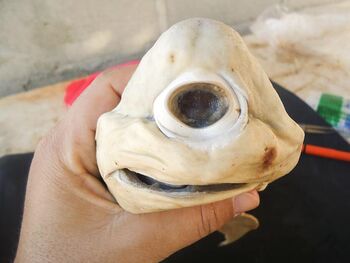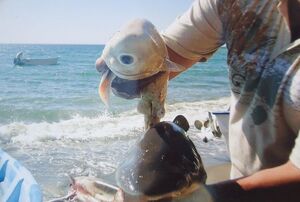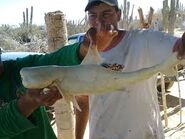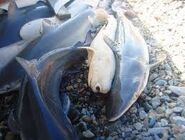
The Corpse of the Cyclops Shark
While one thinks of the cyclops of greek mythology and Kabandha of Southeast Asian lore, a rare creature, dubbed a "one eye anomaly" by National Geographic was discovered in 2011 and still continues to baffle scientists today. The cyclops shark was discovered by fisherman Enrique Lucero León and was instantly regarded as a cryptid and a hoax. However, after Enrique brought the specimen to National Geographic scientists, the cyclops was found to be an actual, real animal. Talk about a one-of-a-kind discovery—an extremely rare cyclops shark (pictured) has been confirmed in Mexico, new research shows.
The 22-inch-long (56-centimeter-long) fetus has a single, functioning eye at the front of its head—the hallmark of a congenital condition called cyclopia, which occurs in several animal species, including humans.

The pup
Earlier this year fisher Enrique Lucero León legally caught a pregnant dusky shark near Cerralvo Island in the Gulf of California. When León cut open his catch, he found the odd-looking male embryo along with its nine normal siblings. "He said, That's incredible—wow," said biologist Felipe Galván-Magaña, of the Interdisciplinary Center of Marine Sciences in La Paz, Mexico.
Once Galván-Magaña and colleague Marcela Bejarano-Álvarez heard about the discovery—which was put on Facebook—the team got León's permission to borrow the shark for research. The scientists then x-rayed the fetus and reviewed previous research on cyclopia in other species to confirm that the find is indeed a cyclops shark.
Cyclops sharks have been documented by scientists a few times before, also as embryos, said Jim Gelsleichter, a shark biologist at the University of North Florida in Jacksonville. The fact that none have been caught outside the womb suggests cyclops sharks don't survive long in the wild.
Overall, finding such an unusual animal reinforces that scientists still have a lot to learn, Gelsleichter added.
'"It's a humbling experience to realize you ain't seen it all yet."



